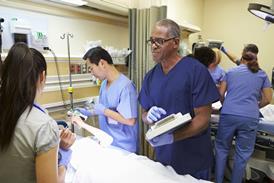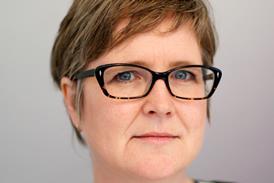Smarter systems and workforce skills development can help multidisciplinary teams deliver better cancer care. By Jennifer Trueland

ING_19064_06177
According to this summer’s report from the independent cancer taskforce, the multidisciplinary team (MDT) model has “revolutionised our approach to cancer treatment in the last 15 years”.
The taskforce, however, goes on to warn that the teams - although regarded as the gold standard for treatment - are not operating as efficiently as they could.
Perhaps this is not surprising. Although National Institute for Health and Care Excellence guidance stresses that all cancer patients should be treated by an MDT, getting it right tends to involve getting a number of senior people, often based in different locations across a region, in the same room at the same time. Logistically, and in terms of people costs and transport budgets, this is a challenge.

And as cancer care changes, not least because the number of people living with cancer is expected to increase as more people survive, the MDT and the way it works will only face more challenges.
The benefits of the MDT - a team of specialists who work together to plan the treatment for an individual patient - are well recognised. Patients managed by an MDT are more likely to receive accurate diagnosis, be offered a choice of treatments, receive better coordination and continuity of care through all stages of the cancer, and be treated in line with locally agreed policies and national guidelines.
Getting the MDT right, therefore, is good for patients and for outcomes.
‘Clinicians from six DGHs can now play an active role in the MDT without leaving their place of work’
So what are the challenges and barriers to making the improvements called for in the independent cancer taskforce report?
One is that cancer networks can stretch over large distances and cover huge populations. For example, Yorkshire and the Humber, the fifth largest region in England, has a population of over 5 million living in around 15,000 sq km - some of this area being particularly rural. Travel distances to the internationally renowned cancer centre at St James’s University Hospital in Leeds mean that attending an MDT meeting can take up as much as a full day of a clinician’s time. Multiply that by the number of specialists who are part of the team, including radiologists, specialist nurses, oncologists, allied health professionals and others, and you are talking about a large (and expensive) human resource. Plus, while clinicians are offsite, they are not available to see the patients back on home turf.
Terry Espiner on why video should be commonplace
As the NHS moves towards digitisation, the emphasis must be on using technology to address clinical and business issues. Innovation in digital technology moves quickly, and nowhere more so than in the area of standards based video and collaboration.
As I have met with NHS trusts, I have seen and heard about so many innovative uses of technology that are making an enormous difference to patient care. Rightly so because if we technology companies are not helping trusts to improve patient care, then why not? Is the NHS a laggard with technology adoption? I think not. And no, I have not forgotten that technology is just a piece of the jigsaw: people, process and culture are equally important - in fact more so.

Yet there is one area about which I rarely hear anything good said. And that is the adoption of video and collaboration technologies into multidisciplinary team (MDT) meetings. The reality is that the NHS is littered with failed video projects which have tarnished the reputation of the technology. And yet I, and many of my colleagues in Cisco, have access to affordable, simple to use video technologies as if by right. To the extent that, quite frankly, life without video would now be unthinkable.
Today things have changed. If you can dial a telephone number or click the button of a mouse, you are in business. It really is that simple, regardless of whether you are taking part in the conference from a fully equipped video room, a desk based system or indeed from your laptop, tablet or smartphone. You’re in control, not the technology. Sounds interesting?
In 2014, Cisco was asked by Leeds Teaching Hospitals Trust to assist in setting up a live MDT meeting between clinicians in Leeds and their counterparts at the King Hussein Cancer Center in Jordan via the internet (see case study, overleaf).
The meeting was to take place in front of members of the Jordanian royal family. No pressure then.
And guess what? It worked.
So if it worked between Leeds and Jordan, what could be done for MDT services across Leeds and its partner organisations?
Don’t we all have a duty of care to see solutions such as this rolled out nationally? I certainly believe so.
Terry Espiner is client director of UK healthcare, Cisco Systems Ltd
Increasing efficiencies
Leeds Teaching Hospitals Trust has recently transformed the way it runs MDT meetings. Installation of modern video conferencing facilities means that clinicians from six district general hospitals across the patch can now play an active role in the MDT without leaving their place of work.
This, says lead cancer clinician Geoff Hall, means that the patient benefits from the collaboration of people involved in his or her care, while the clinician saves valuable time previously lost to travel. “It’s making a huge difference,” he says. “Everybody recognised the inefficiency of having to travel for meetings, but we knew that face to face interaction was very important. Now we can have that valuable face to face without the travel time.”
Technology might seem the obvious answer but take up has been slow, with some clinicians and other decision makers reluctant to adopt this approach.
The early days of video with its dial up links via ISDN could result in poor quality and frustration. Although the technology has now moved on, getting that message across can be difficult, especially to those scarred by encounters with older systems. Ironically, people now use platforms such as Skype and FaceTime in their home lives but leave these behind when they go to work.
Technology and distances to travel are not the only challenges facing MDTs.
‘Many MDTs are under increasing pressure to deliver specialist care in a complex environment’
Developing the workforce is a hugely important element in making sure that patients and the NHS alike can benefit from an MDT process that works smoothly and efficiently.
According to Juliet Bouverie, director of services and influencing at the charity Macmillan Cancer Support, while MDTs often deliver high quality of care for cancer patients, staff must be supported and equipped to do so.
In the recent report from the cancer taskforce, she called for support from the government and NHS to fully fund and implement the recommendations around workforce.
“As more and more people are diagnosed with cancer, and many are living longer with the disease, cancer is becoming a far more complex illness,” she says. “This means many MDTs are now under increasing pressure to deliver specialist care in a complex environment.
“We need to ensure we are taking a strategic approach to the cancer workforce. This includes breaking down barriers in how care is provided, and ensuring that the workforce has the right skills, training and behaviours… to deliver high quality and compassionate care - whether in a team or individually.”
When the independent cancer taskforce published its report in July, chair Harpal Kumar said it was time for action.
Three previous cancer strategies had done a great job of setting England on the path to a world class cancer service, he said, but it was still, however, “a long way away from where we should be”.
“Our expectation is that the government will make the investments required to implement this strategy with commitment and speed,” he said at the time.
Clearly, ensuring that each MDT works as efficiently as possible would be an important step on the way.
Special report: Adopt team tactics
- 1
 Currently reading
Currently readingSpecial report: Adopt team tactics
- 2



























No comments yet